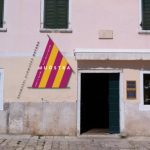July the 19th, 2019 – A look at yet another valuable piece of UNESCO heritage – the Cathedral of St. James in Šibenik. The cathedral was constructed between 1431 to 1535, works that lasted for almost 105 years, and it represents one of the greatest examples of monumental arts in Northern Italy, Dalmatia, and Tuscany from the 15th and 16th centuries.
The cathedral was inscribed on the UNESCO World Heritage list back in 2000, and the criteria for its inscription were the structural characteristics of the cathedral which make it unique.
The cathedral of St. James is considered one of the most valuable architectural work for the aforementioned period in Croatia, and it represents the most significant monument in Šibenik.
UNESCO/YouTube
The cathedral is a unique example of European sacral architecture based on its beauty, construction technique, and style characteristics. The three architects responsible for its construction were Francesco di Giacomo, Georgius Mathei Dalmaticus, locally known as Juraj Dalmatinac, and Niccolo di Giovanni Fiorention, locally known as Nikola Firentinac.
The cathedral has successfully blended both Gothic and Renaissance forms.
It is the only cathedral in Europe made entirely of stone, as no wooden architectural elements were used for its construction. It is also the first building in Europe where its construction was based on the unique system of inter grooved stone plates. A structure like this didn’t exist before the 19th century, in addition to all of that, it is the only structure with an outside volume which corresponds entirely with the shape of its interior.
St. James’ Cathedral is well known for its iconographic innovation, and what is uniquely recognisable are its outdoor decorations, with 74 head sculptures from the then contemporaries of Juraj Dalmatinac. This is the biggest and the best quality gallery of portraits displayed in the form of a public monument on a sacral object in Europe.
The dome, formed in a semi-circular shape, was built entirely from stone by the montage way of building. The front of the cathedral has Renaissance and Gothic elements made both by Juraj Dalmatinac and Bonino da Milano.
The cathedral is built on the south side of the central city square in the old town centre on the location of then Romanesque church of St. James. The idea of creating a large cathedral first began in the 13th century, when Šibenik got its bishop’s residence and earned its city status. Construction then began in 1431, lasting for 105 years until 1536.
REDERLights/YouTube
The construction began in Venetian Gothic style and finished in Tuscan Renaissance style. This Šibenik cathedral boasts a three-nave basilica and is 38 metres long and 14 metres wide. Its highest point is the top of the dome.
The architects in charge of construction during the first decades of the 15th century were Venetians Francesco Giacomo, Antonio Busato and Lorenzo Pincino. They worked on the cathedral together with Šibenik stonemasons Andrija Budčić and Grubiša Statčić. In 1441. Juraj Dalmatinac was appointed as proto-master and worked on the construction of the cathedral until his death in 1475. As the master of the late Gothic flower style and a pioneer of Gothic-Renaissance style in Dalmatia, Juraj Dalmatinac changed the initial plan for the church and gave it monumental importance.
After the death of Juraj Dalmatinac, Nikola Firentinac continued the construction in Renaissance style. Due to the fact that the cathedral wasn’t finished, Venetian architects Bartol and Jakov from Mestre and Mestičević from Zadar took over the construction.
The central part of the cathedral is the baptistery, which represents the creative synthesis of two different art styles of the first half of the 15th century – the Late Gothic and the Early Renaissance periods. The cathedral represents the first finished work of architecture in Renaissance style, constructed only twenty years after the real beginning of the Renaissance in Tuscany.
The baptistery has many decorations, mostly of human images. Juraj Dalmatinac made four sculptures, of which just two have remained preserved. The baptistery has reliefs with angels, cherubs’ heads, the image of Father God and the dove that represents the Holy Spirit. The centre of the baptistery has sculptures of three naked boys in movement.
From the 16th century onwards, after the end of the cathedral’s construction, there have been continuous reconstruction and renovation works, mostly for leaking issues. In the second half of the 19th century, there was more significant reconstruction, and then after the Second World War came to a close, another reconstruction began.
During the Homeland War during the 1990’s, the dome was damaged and reconstructed in 1997, but there is a constant need for restoration even today.
St. James’ Cathedral is a masterpiece made during times when the art was flourishing in Europe, and it has remained until this very day as a piece of priceless heritage for the world to come and admire.
Cities in 4K/YouTube
Follow our dedicated lifestyle page for much more on Croatia’s UNESCO heritage.
SOURCE(S): UNESCO, TZ Šibenik-Knin County, TZ Šibenik, Šibenska biskupija








